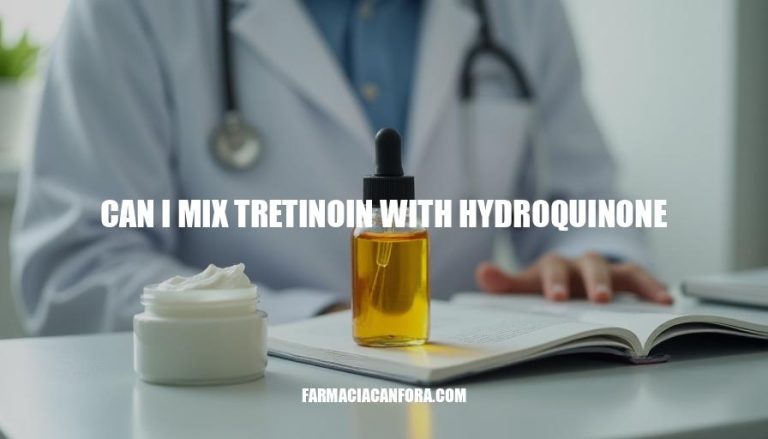


Tretinoin is a powerful ingredient that helps skin cells turn over faster. This makes it great for treating acne, reducing fine lines, and improving skin texture.
Hydroquinone is another ingredient that lightens the skin by stopping melanin production. It’s often used to treat dark spots and hyperpigmentation.
When you use tretinoin and hydroquinone together, they work really well to address stubborn hyperpigmentation and uneven skin tone.
Tretinoin helps hydroquinone penetrate deeper into the skin, making it more effective. Together, they create a powerful combination that targets pigmentation from multiple angles.
However, this combo should only be used under the guidance of a dermatologist to avoid any irritation or complications.
Combining tretinoin and hydroquinone can be a powerful approach to addressing skin concerns, particularly hyperpigmentation and melasma. Tretinoin, a derivative of vitamin A, accelerates skin cell turnover, helping to exfoliate the skin and reduce the appearance of dark spots. Hydroquinone, on the other hand, inhibits melanin production, effectively lightening areas of hyperpigmentation.
Together, these compounds work synergistically to enhance each other’s effects, leading to a more even skin tone and improved texture.
Despite their benefits, the combination of tretinoin and hydroquinone carries risks. Common side effects include redness, dryness, irritation, peeling, and increased sensitivity to sunlight. Rarely, prolonged use of hydroquinone can lead to ochronosis, a condition characterized by blue-black skin discoloration.
Overuse or improper application may exacerbate these issues, making it crucial to follow a structured regimen.
Precautions are essential when using these compounds. Gradual introduction, starting with lower concentrations and limited frequency, can help minimize irritation. Sunscreen with SPF 30 or higher should be used daily to protect the skin from UV damage, which can worsen pigmentation.
Patch testing and step-by-step layering are recommended to ensure compatibility and effectiveness.
Professional consultation is vital before combining tretinoin and hydroquinone. Dermatologists can assess individual skin types and conditions, prescribe appropriate concentrations, and provide guidance on usage. They can also monitor progress and adjust treatment plans to avoid adverse effects.
Consulting a professional ensures safe and effective use, maximizing benefits while minimizing risks.
1miiskin.com2okdermo.com3www.dermatologistschoice.com4www.prime360care.com5www.realself.com
Mixing tretinoin and hydroquinone can be an effective approach to addressing hyperpigmentation and uneven skin tone, but it requires careful consideration and guidance from a dermatologist.
Tretinoin helps skin cells turn over faster, reducing fine lines and acne, while hydroquinone lightens the skin by stopping melanin production.
When used together, they work synergistically to enhance each other’s effects, leading to a more even skin tone and improved texture. However, this combination carries risks, including redness, dryness, irritation, peeling, and increased sensitivity to sunlight.
Rarely, prolonged use of hydroquinone can lead to ochronosis, a condition characterized by blue-black skin discoloration.
To minimize these issues, it’s essential to follow a structured regimen, starting with lower concentrations and limited frequency, and using sunscreen daily to protect the skin from UV damage. Patch testing and step-by-step layering are also recommended to ensure compatibility and effectiveness.
A professional consultation is vital before combining tretinoin and hydroquinone, as dermatologists can assess individual skin types and conditions, prescribe appropriate concentrations, and provide guidance on usage. They can also monitor progress and adjust treatment plans to avoid adverse effects, ensuring safe and effective use that maximizes benefits while minimizing risks.